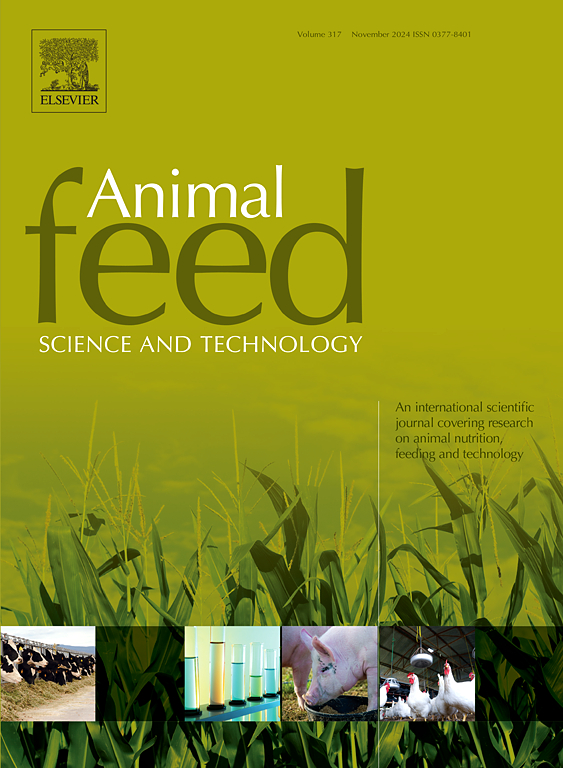Dietary berberine supplementation improves growth performance, liver-related blood parameters, and antioxidative status of fattening lambs
IF 2.7
2区 农林科学
Q1 AGRICULTURE, DAIRY & ANIMAL SCIENCE
引用次数: 0
Abstract
This study determined the effect of berberine (BBR) supplementation on the performance, carcass traits, and antioxidant status of fattening lambs. Twenty-one male Baluchi lambs [three-month-old with 26.5 ± 2.10 kg of body weight (BW), mean ± standard deviation (SD)] were randomly assigned to one of three groups (n = 7 per group) with different BBR supplementation including 0 g/d (Ctrl), 0.5 g/d (BBR0.5), and 1.0 g/d (BBR1) for 60 days after 14 days of adaptation. On days 0, 30, and 60 lambs were weighed individually and blood samples were collected. Dietary BBR supplementation tended (p = 0.061) to increase dry matter intake (DMI). Also, total weight gain (TWG, p = 0.009) and average daily gain (ADG, p = 0.009) of lambs in both BBR0.5 and BBR1 groups was higher than Ctrl. The lowest plasma triglycerides (TG, p = 0.033) and cholesterol (CHOL, p = 0.046) were for BBR1 followed by the BBR0.5 group, both lower than those in Ctrl. Also, the levels of aspartate aminotransferase (AST, p = 0.048) and alkaline phosphatase (ALP, p = 0.031) were mitigated in BBR1-supplemented lambs compared to Ctrl group. Also, BBR favors the antioxidant status of fattening lambs as indicated by enhanced blood total antioxidant capacity (TAC), and superoxide dismutase (SOD) along with depressed malondialdehyde (MDA) levels. The hot carcass weight (HCC) increased (p = 0.077) with increasing BBR supplementation, while cold carcass weight (p = 0.495) and dressing BW (p = 0.144) were not affected. In conclusion, BBR positively influenced the growth performance and antioxidant status of fattening lambs, potentially supporting better health and production. Further research is warranted to explore its effects on meat quality and oxidative stability.
饲粮中添加小檗碱可改善育肥羔羊的生长性能、肝脏相关血液参数和抗氧化状态
本研究旨在确定添加小檗碱(BBR)对育肥羔羊生产性能、胴体性状和抗氧化状态的影响。选取21只3月龄体重(26.5 ± 2.10 kg)的俾路支公羔羊[平均±标准差(SD)为26.5 ± kg],随机分为3组(每组 = 7只),分别添加0 g/d (Ctrl)、0.5 g/d (BBR0.5)和1.0 g/d (BBR1)的BBR,适应14 d,持续60 d。第0、30和60天分别称重羔羊并采集血样。饲粮添加BBR有增加干物质采食量(DMI)的趋势(p = 0.061)。BBR0.5组和BBR1组羔羊的总增重TWG (p = 0.009)和平均日增重ADG (p = 0.009)均高于对照组。血浆甘油三酯(TG, p = 0.033)和胆固醇(CHOL, p = 0.046)以BBR1组最低,其次为BBR0.5组,均低于对照组。与对照组相比,添加bbr1的羔羊的天冬氨酸转氨酶(AST, p = 0.048)和碱性磷酸酶(ALP, p = 0.031)水平也有所降低。此外,BBR有利于育肥羔羊的抗氧化状态,这可以通过提高血液总抗氧化能力(TAC)和超氧化物歧化酶(SOD)以及降低丙二醛(MDA)水平来证明。随着BBR添加量的增加,热胴体重(HCC)增加(p = 0.077),而冷胴体重(p = 0.495)和屠宰体重(p = 0.144)不受影响。综上所述,BBR对育肥羔羊的生长性能和抗氧化状态有积极影响,可能有助于改善健康状况和产量。其对肉质和氧化稳定性的影响有待进一步研究。
本文章由计算机程序翻译,如有差异,请以英文原文为准。
求助全文
约1分钟内获得全文
求助全文
来源期刊

Animal Feed Science and Technology
农林科学-奶制品与动物科学
CiteScore
6.00
自引率
6.20%
发文量
266
审稿时长
3 months
期刊介绍:
Animal Feed Science and Technology is a unique journal publishing scientific papers of international interest focusing on animal feeds and their feeding.
Papers describing research on feed for ruminants and non-ruminants, including poultry, horses, companion animals and aquatic animals, are welcome.
The journal covers the following areas:
Nutritive value of feeds (e.g., assessment, improvement)
Methods of conserving and processing feeds that affect their nutritional value
Agronomic and climatic factors influencing the nutritive value of feeds
Utilization of feeds and the improvement of such
Metabolic, production, reproduction and health responses, as well as potential environmental impacts, of diet inputs and feed technologies (e.g., feeds, feed additives, feed components, mycotoxins)
Mathematical models relating directly to animal-feed interactions
Analytical and experimental methods for feed evaluation
Environmental impacts of feed technologies in animal production.
 求助内容:
求助内容: 应助结果提醒方式:
应助结果提醒方式:


